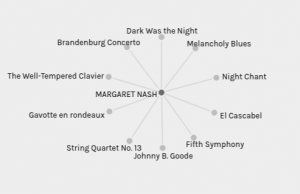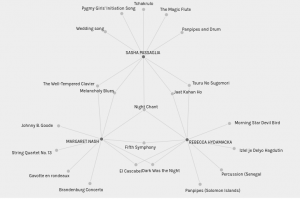
What a jumbled mess … when I first opened the Palladio program and uploaded our class file I honestly just stared at the screen for a bit. After not being able to make much sense of it, I started to zoom in and out, finding clarity when I could recognize names of classmates and songs. I started to see their links.

When I looked at only my own name, the graph became easier to understand. As described in System Innovation’s video “Graph Theory Overview” (2015), I recognized these undirected graphs – that connections, or edges, between the nodes have no direction. Our names are linked to the songs we chose and the songs are linked to our names.

Looking at the smaller group I was put in on Palladio, I noticed that Robin, Tyler and I shared 6 songs – not bad considering there were 27 to choose from! There were other adjacent relations between songs and one other person. Oddly symmetrical was the fact that each of us had two songs that neither of the other two picked.

Intrigued looking at the relations between members of the group I was assigned, I wanted to compare my choices with another group. Seeing as we were just about to start the ETEC 565S summer institute, I grabbed my project group to compare our choices. The visual layout of this multiplex network was beautiful! We only share one song in common so it appears that the network is resonating from the node of “Night Chant“.
A definite downfall of these groupings is that the rationale for choosing a song is not considered. For example, I chose the 10 songs that I liked the most and/or had a positive memory that the song reminded me of. In speaking with some classmates, they chose some songs that they did not like to include in their 10. This means that even though there are relations between nodes (people and their song choices) it does not mean that these people necessarily have similar interests or things in common.
This has implications for networking search functions on the web because when people are searching for something, they may be broad in their search terms. This may link their search to information that does not align to their idea of the topic they were searching. These relations between nodes (search terms) could be very arbitrary.
These assumptions about relations has far reaching implications. From a political standpoint, just because two people have the same political affiliations does not mean that they have similar views, ideas or interests. More research would be needed to determine if they had anything else in common.
Lastly, out of interest, I looked at the songs instead of the people to see which ones were picked the most and the least. The most popular song chosen (by 17 people) was The Fifth Symphony which is not surprising given its popularity in popular culture. Interestingly, all of the 27 Golden Record songs were chosen – at least once. And only one song had just one person pick it: Men’s House Song. I thought I’d link it here so it could maybe get a bit more play! After listening to it again, I still don’t think I would include it on my short list …
_______________________
System Innovation. (2015, April 18). Graph Theory Overview. Retrieved from https://www.youtube.com/watch?v=82zlRaRUsaY&feature=emb_logo
System Innovation. (2015, April 19). Network Connections. Retrieved from https://www.youtube.com/watch?v=2iViaEAytxw

